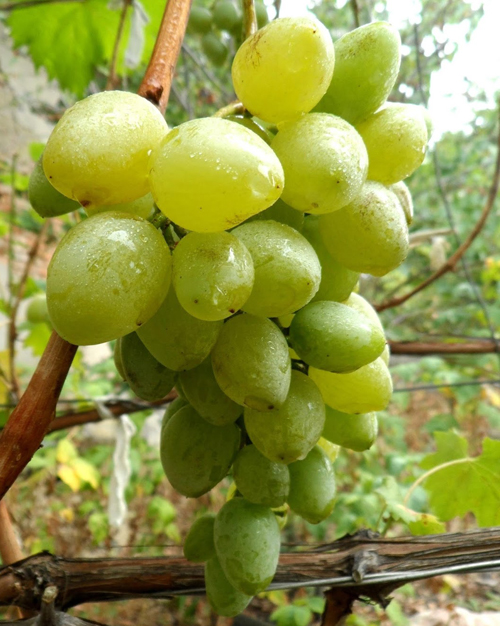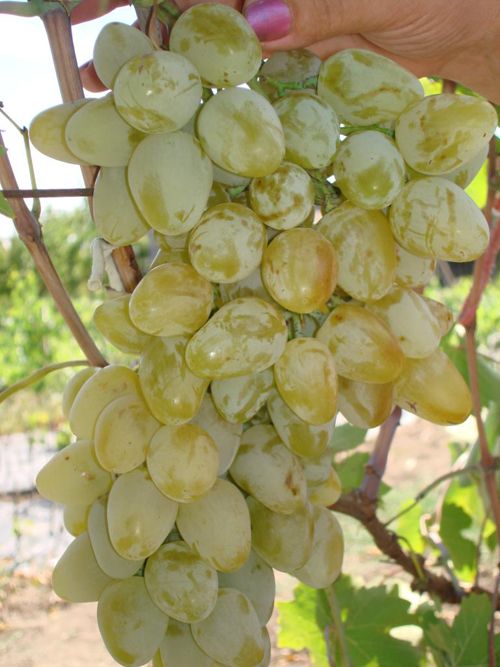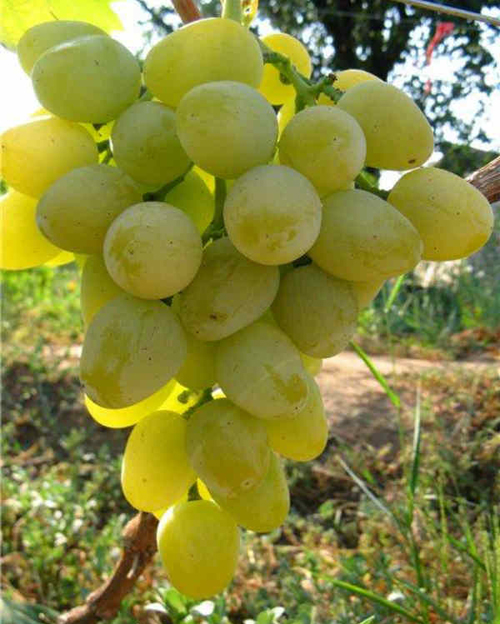Monarch grape variety
Monarch is a very successful hybrid form of table grapes, originally bred on the personal plot of the famous amateur breeder Yevgeny Georgievich Pavlovsky from Novoshakhtinsk, Rostov Region, Russia. In the past, a simple miner, since 1985, Evgeny Georgievich, at the call of his soul, began to engage in selection, and quite successfully. Many of its hybrids have won awards and prizes at various exhibitions and competitions, and most importantly, they have won recognition and popularity among winegrowers.

One of these popular varieties is the Monarch, obtained as a result of complex hybridization, in which at first the Cardinal's flowers were pollinated with a mixture of pollen of different varieties, and then the resulting hybrid form was used as a paternal form in a pair with the famous Talisman... The result is a hybrid of grapes with outstanding berry sizes, almost plum caliber, of a beautiful golden straw color with a reddish tan in the sun. In addition, the new variety has a high yield, good sugar accumulation, a very pleasant taste and increased frost resistance.
Our hero has been officially entered into the State Register of Breeding Achievements of the Russian Federation since 2015, where he appears under the name Chrysolite, as it turned out that a variety with the name Monarch already exists in Germany. Approved for horticultural use. The patent holder is the Kuban State Agrarian University named after I.T. Trubilin.
Agrobiological characteristics
The vigor of the grape bushes is above average. The leaf of the variety is large, rounded, five-, less often three-lobed, slightly dissected. The leaf blade is reticulate-wrinkled from above, from below it has a barely noticeable cobweb pubescence. The upper lateral notches are shallow, open with parallel sides and a sharp bottom, the lower ones are barely marked, the petiole is open lyre-shaped with a narrow aperture and a rounded bottom. The denticles along the edge of the leaf are large, triangular with a base of medium width. The flower of the Monarch is bisexual, pollinates well, but is prone to shedding the ovary in unfavorable years.

The bunches of the variety are large, with an average weight of 600-1000 grams, but due to the relatively small number of very large berries in the cluster, they visually seem very compact. Conical or cylindro-conical shape, moderate density. The comb is long, the stems of the berries are of medium length, strong. Berries are aligned, oblong-ovoid, outstanding in size. Their length reaches 45 mm, diameter - up to 30 mm, weigh on average 15-20 grams, but on small bunches ripened on powerful shoots, they can reach 30 grams. The pulp of the grapes is juicy-fleshy, moderately dense, harmonious taste with a light nutmeg aroma. The juice is colorless. The skin is of medium thickness, crispy, edible, yellow in color with a reddish tan on the side facing the sun. 2-3 seeds, they are not large, easily separated from the pulp, do not have a negative impact on the tasting assessment. After ripening, the bunches of the Monarch can remain on the bushes for a long time; under normal weather conditions they do not crack or rot.
The grape harvest is intended for fresh consumption. The variety enjoys increased attention from buyers who are delighted with the gigantic size of the berries and their attractive color. The bunches are well suited for long-distance transport and, being neatly collected, keep well in cool, dry rooms.

Ripening period - early-middle. From bud break, 120-130 days are enough until the onset of the removable maturity of the bunches. In the south, this is about the second half of August, in the middle lane - the beginning of September. The required sum of active temperatures is 2650-2750 ° C. The yield is very high, in the state test Monarch showed a phenomenal result - 239.5 c / ha. It is not a problem to get ten or more kilograms of bunches from a bush.The frost resistance declared by the originator is quite high - -23-25 ° C, however, in the approval for use, the hybrid is indicated as a covering one. The vine usually ripens up to 2/3 of its length. The fruitfulness of shoots is from 60 to 75%, the number of clusters for each fruitful shoot is on average about 1.3. The sugar content in the berry at the time of reaching ripeness is 17.3 g / 100 cubic meters. cm, acidity 6.1 g / cubic dm. The sugar-acid ratio is harmonious, the overall grape tasting score is 8.6 points.
Agrotechnical features
The variety is quite demanding to care for. First of all, this concerns the rationing of bushes with a harvest, which the Monarch has its own characteristics, as well as the protection of plants from certain diseases.
The form of bush management must be selected in accordance with the existing climatic conditions. The declared winter hardiness allows you not to worry about the safety of the vine in the south, however, in more frost-prone regions, it will be necessary to shelter the grapes for the winter. In the first case, standard formations with two-armed horizontal cordons are recommended, and in the second, fan-shaped multi-arm options. An intermediate form is also possible, when no shelter is provided for the main part of the bush, and only in its lower part a lightweight reserve sleeve is formed, which is sheltered for the winter.
Regulation of the load of the Monarch, like any other high-yielding variety, is necessary, however, due to the tendency of the hybrid to shatter the ovary, it requires certain specificity. So, the removal of extra bunches on the bush must be done not at the usual time, but only after the start of the growth of grapes, when they reach the size of a pea. Depending on personal preference, you can leave either powerful clusters, and then a lot of medium-sized berries will grow on them, or small tassels that compensate for the number of berries by their outstanding sizes. It is recommended to choose a rather modest total load on the plant - 25−35 eyes with a pruning length of 4−6 buds. A moderate load will also contribute to better ripening of the shoots, which in turn will have a positive effect on the winter hardiness of the entire plant.
The variety does not shine with resistance to diseases. If in relation to mildew it is enough to carry out preventive treatments, then oidium poses a high danger to the Monarch. There are many fungicides to combat this disease, but it is better to use time-tested preparations based on colloidal sulfur. They do not accumulate in plant tissues, and in addition to fighting powdery mildew, they inhibit the vital activity of such pests of grapes as mites. The main thing is to strictly follow the instructions for use, since its violation can harm the vineyard itself.
Our hero is not resistant to phylloxera, and therefore in regions of soil contamination with it, the propagation of the vine by grafting onto a phylloxera-resistant stock is required. However, gourmets who have tasted the berries from both grafted and rooted bushes claim that the latter have an order of magnitude higher taste.
We can only rejoice for those lucky ones who have not yet reached the harmful pest, and strongly recommend them to pay close attention to the Monarch. Having planted it on their site in their own-rooted culture and provided proper care, they can be sure that they have opened up the possibilities of the variety one hundred percent. Those who have to deal only with grafted grape seedlings should not despair, after all, taste assessments are a purely individual matter, and the big difference in this case seems to be very controversial.








